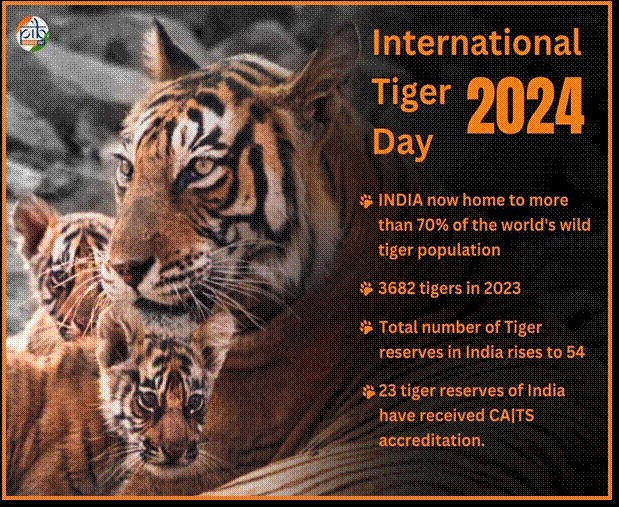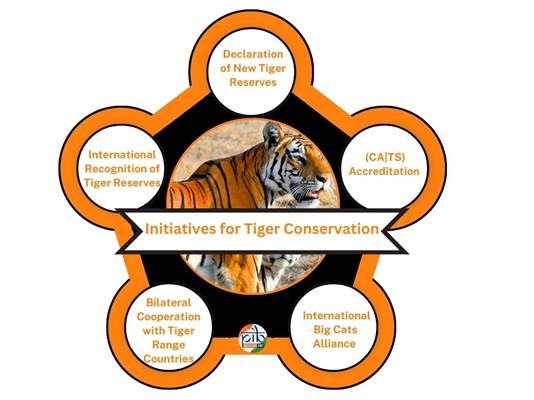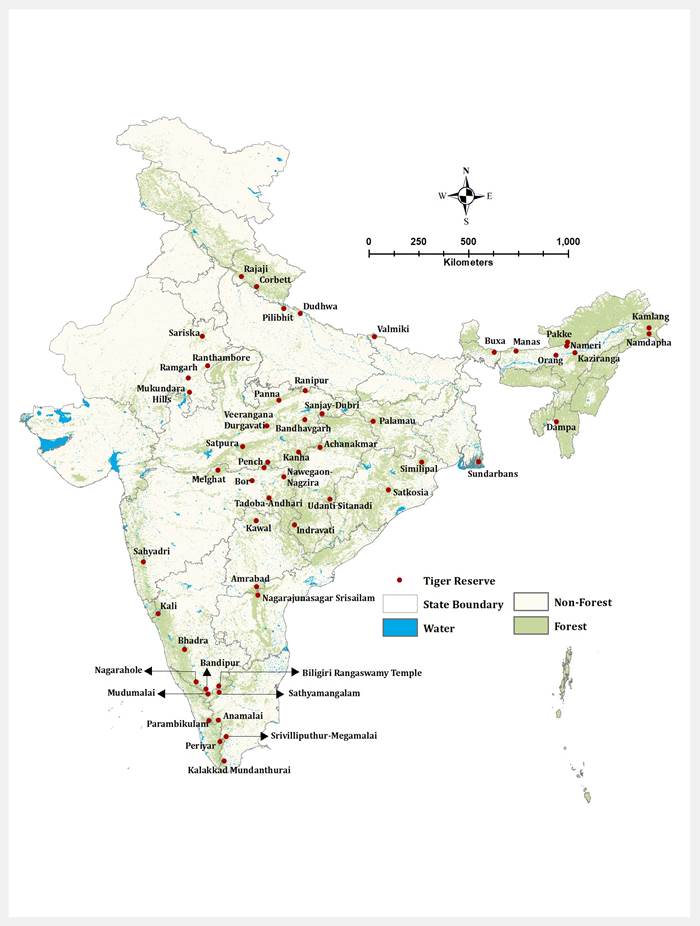Others
International Tiger Day 2024
A Global Commitment to Tiger Conservation
Posted On:
28 JUL 2024 9:47AM
Every year on July 29, International Tiger Day is celebrated to highlight the importance of tiger conservation across the globe. The declaration to celebrate this day was made on July 29, 2010, in St. Petersburg, aiming to unite all tiger range countries in a concerted effort to enhance tiger conservation and management worldwide. This day serves as a platform to raise awareness about the challenges faced by these magnificent creatures and the efforts being made to safeguard their future.

Tigers in India
As per the 5th cycle of the All India Tiger Estimation 2022 (usually done in cycles of four years) summary report, India has a minimum of 3,167 tigers and is now home to more than 70% of the world's wild tiger population. Further data analysis using the latest statistical models for camera-trapped and non-camera-trapped tiger presence areas estimates the upper limit of the tiger population at 3,925, with an average number of 3,682 tigers, reflecting a commendable annual growth rate of 6.1%. This remarkable conservation feat has been achieved due to the pioneering initiatives undertaken by the National Tiger Conservation Authority, Government of India, in collaboration with State Governments.

Historical Journey of Tiger Conservation in India
By the mid-20th century, India's tiger population was in a rapid decline due to hunting, habitat loss, and other human activities. Following independence in 1947, this decline became even more pronounced, with the tiger population reaching alarmingly low numbers.
- Initial Steps Toward Conservation
Alarmed by this dismal trend, the Indian Board for Wild Life (IBWL) convened a meeting in New Delhi in July 1969. The board recommended a total ban on the export of all wild cat skins, including those of tigers. This crucial step was supported by the International Union for Conservation of Nature (IUCN), which met in Delhi the same year. The IUCN's 10th Assembly included the tiger in its “Red Data Book” as an endangered species and called for a global ban on tiger killings.
- Formation of the Tiger Task Force and Project Tiger
In response to the growing concern, the IBWL's Executive Committee formed an 11-member Task Force to investigate the issue and devise a comprehensive conservation strategy. This initiative marked the inception of Project Tiger. The Task Force submitted its final report in August 1972, recommending that eight tiger forests across India be included in the project. On April 1, 1973, Project Tiger was officially launched at the Corbett Tiger Reserve. The initial phase included nine tiger reserves:
- Corbett (Uttar Pradesh)
- Palamau (Bihar)
- Similipal (Orissa)
- Sundarbans (West Bengal)
- Manas (Assam)
- Ranthambhore (Rajasthan)
- Kanha (Madhya Pradesh)
- Melghat (Maharashtra)
- Bandipur (Mysore)
These reserves represented a diverse range of tiger habitats across the country.

- Legal and Structural Strengthening
The modern era of wildlife conservation in India began with the enactment of the Wildlife (Protection) Act in 1972. Influential figures like J. C. Daniel and renowned ornithologist Salim Ali from the Bombay Natural History Society played pivotal roles in driving this legislative change. Government of India with World Wildlife Fund launched Project Tiger in 1973 as a centrally sponsored scheme covering nine protected areas. Notably, Project Tiger completed 50 years in 2023 for which a commemorative event was held in which Prime Minister Shri Narendra Modi launched the ‘Amrit Kaal Ka Vision For Tiger Conservation’.
- Tiger Task Force Report and National Tiger Conservation Authority (2006)
In 2005, the Tiger Task Force submitted a report to the Government of India, leading to significant amendments to the Wildlife (Protection) Act in 2006. These amendments resulted in the establishment of the National Tiger Conservation Authority (NTCA) and the Wildlife Crime Control Bureau as statutory bodies. This transformation turned Project Tiger from a mere funding scheme into a reciprocal commitment involving the central government (NTCA), state governments (Chief Wildlife Wardens), and tiger reserves (Field Directors).
- Global Efforts and International Collaborations
In 2010, Global Tiger Reserve Day was celebrated to raise awareness and bolster international efforts for tiger conservation. Recognizing the critical situation of wild tiger populations, world leaders and conservation experts convened in St. Petersburg, Russia, to devise strategies for tiger recovery. This landmark event marked the first time in history that national leaders gathered specifically to address the conservation of a species. The meeting resulted in the Global Tiger Recovery Program, which outlined actions to be taken individually or collectively by tiger range countries to increase the global tiger population from approximately 3,643 in 2010 to around 5,870 by 2022 and to protect tiger habitats.
The journey of tiger conservation in India has evolved from initial bans on hunting and trade to sophisticated, multi-faceted conservation strategies involving legal frameworks, international cooperation, and community engagement. The sustained efforts have contributed to a hopeful future for tigers and other big cats, not just in India but across the globe.

Recent Initiatives for Tiger Conservation in India
- Bilateral Cooperation with Tiger Range Countries
To enhance transboundary conservation efforts, India has been actively collaborating with neighbouring countries. Notably, on February 14, 2023, a bilateral meeting was held in Kolkata, West Bengal, to promote tiger conservation across the Sundarbans landscape, which spans both India and Bangladesh. Additionally, India and Cambodia signed a Memorandum of Understanding (MoU) focused on "Cooperation in biodiversity conservation and sustainable wildlife management recovery strategy of tiger and its habitat." As part of this bilateral initiative, an Indian delegation visited Cambodia to assess field conditions and capacity-building requirements for a tiger reintroduction program.
- International Recognition of Tiger Reserves
In 2022-23, several Indian tiger reserves received international accolades. The Pench Tiger Reserves in Madhya Pradesh, along with the Satpura Tiger Reserve in Madhya Pradesh, were jointly awarded the prestigious Tx2 award. This award is presented by a consortium of international organizations, including the Global Environment Facility (GEF), United Nations Development Programme (UNDP), International Union for Conservation of Nature (IUCN), World Wildlife Fund (WWF), and Global Tiger Forum (GTF).
- Declaration of New Tiger Reserves
The declaration of the new Veerangana Durgavati" tiger reserve in Madhya Pradesh has increased the total number of tiger reserves in India to 54. These reserves collectively cover more than 78,000 square kilometers, accounting for over 2.30% of India's geographical area. This expansion underscores India's commitment to providing extensive and diverse habitats for tigers.

- Conservation Assured Tiger Standards (CA|TS) Accreditation
The Conservation Assured Tiger Standards (CA|TS) is an international accreditation system that evaluates tiger reserves' management practices to ensure they meet rigorous conservation standards. In the current year, six additional tiger reserves in India have received CA|TS accreditation: Kali, Melghat, Navegaon-Nagzira, Pilibhit, and Periyar. With these new additions, a total of 23 tiger reserves in India have achieved CA|TS accreditation, reflecting the country's dedication to maintaining high standards in tiger conservation.
- Launch of International Big Cats Alliance (IBCA)
During a commemorative program of 50 years of Project Tiger, Prime Minister Shri Narendra Modi launched the International Big Cat Alliance (IBCA) in 2023 for the conservation of seven big cats: Tiger, Lion, Leopard, Snow Leopard, Cheetah, Jaguar, and Puma. The alliance aims to reach out to range countries covering the natural habitats of these big cats. The IBCA seeks to strengthen global cooperation and efforts to conserve these wild denizens.
India's recent initiatives in tiger conservation highlight a multifaceted approach involving international cooperation, recognition of exemplary management practices, expansion of protected areas, and adherence to global standards. These efforts are crucial in ensuring the long-term survival and thriving of tiger populations in India and serve as a model for conservation strategies worldwide.
Click here to see in PDF:
References
https://pib.gov.in/PressReleasePage.aspx?PRID=1991620
https://pib.gov.in/PressReleasePage.aspx?PRID=1943922
https://static.pib.gov.in/WriteReadData/specificdocs/documents/2023/jul/doc2023729230301.pdf
https://pib.gov.in/PressReleaseIframePage.aspx?PRID=2010122
Ministry of Environment, Forest and Climate Change Annual report: https://moef.gov.in/annual-reports
Project Tiger 50 Years of Tiger Conservation in India ebook: https://ntca.gov.in/reports/reports2
Tiger status report 2022: https://ntca.gov.in/
Status of Tigers, co-predators and prey in India-2022-Final Report: https://ntca.gov.in/documents/reports2
Santosh Kumar/Sarla Meena/Sheetal Angral/ Ritu Kataria /Madiha Iqbal
(Backgrounder ID: 151967)
आगंतुक पटल : 20924
Provide suggestions / comments